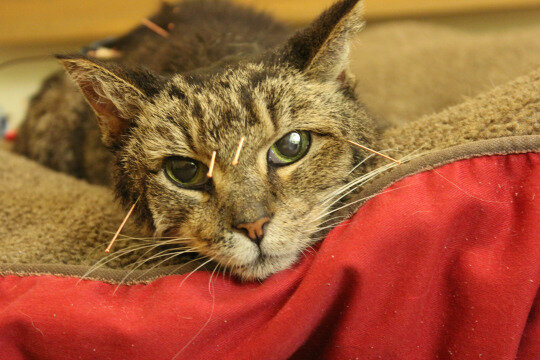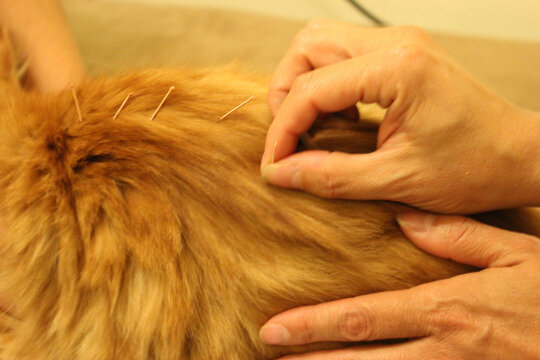Acupuncture
Acupuncture is an extremely safe and effective means of treating or relieving pain associated with joint disease, intervertebral disc disease, inflammatory bowel disease, renal failure, allergies, asthma, chronic pain, respiratory problems, nervous system disorders, muscle spasms and other illnesses your pet may be experiencing.
Acupuncture uses needles to stimulate a neurovascular bundle (small artery, vein and nerve). A very small, very fine needle is gently inserted into the skin causing a release of hormones such as endorphins and cortisol into the bloodstream. These chemicals then affect the way an organ functions, the way the brain perceives pain or blood flow to an area of the body, producing a healing response.
An ancient treatment for humans in China, acupuncture in veterinary medicine began to emerge in the US in the early 1970’s with the creation of the International Veterinary Acupuncture Association (IVAS). Dr. Fuoco received her certification through IVAS and helped bring veterinary acupuncture to Philadelphia when she began practicing in 2004.
For small animals, the insertion of acupuncture needles is virtually painless. Once the needles are in place, there should be no pain. Most animals become very relaxed and may even become sleepy. Nevertheless, acupuncture treatment may cause some sensation, presumed to be those such as tingles, cramps, or numbness which can occur in humans and which may be uncomfortable to some animals.
While a bulk of our acupuncture practice relates to treating canines, some of the most dramatic improvements have been in our felines. Cats respond in some amazing ways to the treatment. Call us to find out more or visit us to see how acupuncture might help your companion in a variety of ways.
FAQS
What is acupuncture and how can it help my pet?
Acupuncture is the insertion of needles to stimulate specific points on the body that have the ability to alter various biochemical & physiological conditions in order to produce a healing response.
An ancient treatment for humans in China, acupuncture in veterinary medicine began to emerge in the US in the early 1970’s with the creation of the International Veterinary Acupuncture Society (IVAS). Today, when practiced by certified veterinarians, acupuncture is recognized throughout the world as a safe and effective means of treating or relieving pain associated with joint disease, intervertebral disc disease, inflammatory bowel disease, renal failure, allergies, asthma, chronic pain, respiratory problems, nervous system disorders and other illnesses your pet may be experiencing.
What conditions respond to acupuncture?
Musculoskeletal Issues: arthritis, hip/elbow dysplasia, disk/joint disease, chronic pain syndromes & neck or back injuries, muscle spasms
Neurological Issues: traumatic nerve injury or paralysis, muscle weakness or paralysis, degenerative nerve conditions, vestibular syndrome, seizures
Skin Problems: lick granulomas, allergies
Respiratory Problems: asthma, chronic lung disease, respiratory changes associated with heart failure
Gastrointestinal Issues: inflammatory bowel disease
Urogenital Problems: renal failure, cystitis
Endocrine Diseases: Cushing’s, Addison’s, diabetes, thyroid issues
Chemotherapy Side Effects: nausea, lethargy, poor appetite
Minor sports issues: strains, sprains or for muscle and tendon resistance to injury
How does it work?
Acupuncture uses needles to stimulate a neurovascular bundle (small artery, vein & nerve). A very small, very fine needle is gently inserted into the skin causing a release of hormones such as endorphins (one of the body’s pain control chemicals) or cortisol (a natural steroid). By choosing the right points, a veterinary acupuncturist can help improve blood flow to a part of the body or a organ, inhibit the sensation of pain in a pet, stimulate nerves and relieve muscle spasms.
What is a treatment like for my pet?
Veterinary acupuncture is often a relaxing experience for your pet. Before therapy can begin, a Traditional Chinese Medical diagnosis is made through a systematic process of observing, touching, listening and inquiring. An acupuncture point or group of points is selected to correct the patient’s imbalances. The insertion of acupuncture needles is often undetected and many patients enjoy the treatments. The majority of dogs & cats go through a typical sequence of responses during treatment. At the onset, they may be apprehensive, followed by a deep, almost sedative relaxation with some patients falling asleep.
How long do treatments last & how often are they needed?
The first appointment will last about an hour & follow-ups are 30 minutes. The frequency of sessions depends on the animal. A simple acute problem, such as a sprain, may require only one treatment, whereas more severe or chronic ailments may need several treatments. Patients often start with 1-2 treatments per week for 4-8 weeks. A positive response is usually seen within 4 treatments. Once a maximum positive response is achieved (usually after 4-8 treatments), appointments are tapered off so that the greatest amount of symptom free time elapses between them. Many animals with chronic conditions can be successfully maintained with a treatment every 1-2 months.



